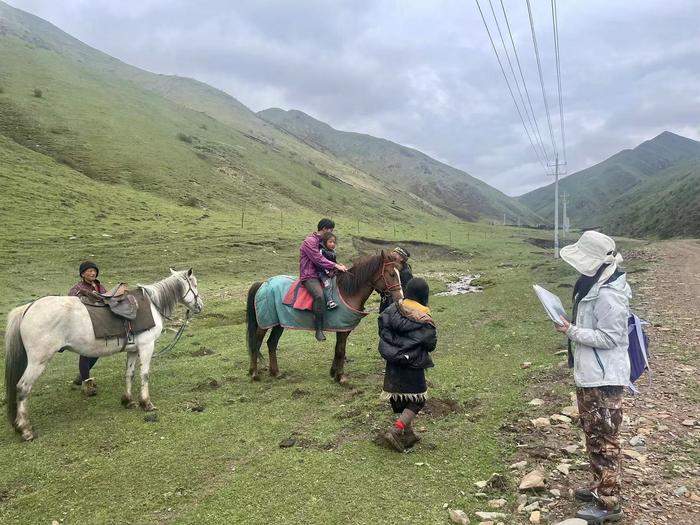Up on the “roof of the world”, one of the world’s largest ecosystem restoration projects is taking place. The Qinghai-Tibetan Plateau (QTP) in western China is the world’s highest plateau and covers a land area roughly five times the size of France.

Credit: Li Li
Up on the “roof of the world”, one of the world’s largest ecosystem restoration projects is taking place. The Qinghai-Tibetan Plateau (QTP) in western China is the world’s highest plateau and covers a land area roughly five times the size of France.
Home to thousands of rare plants and wildlife and the source of water for more than 2.5 billion people, this vital ecosystem is under threat.
The region’s grassland is degrading due to climate change and intense livestock grazing. Government initiatives to restore biodiversity and fertility to the soil are underway, but the lack of engagement from local communities is one of the main causes of failed projects.
A research team comprising local Tibetans and academics from the UK and China has lived among and studied two pastoral communities on the QTP for decades, investigating local attitudes and values to grassland restoration.
The team’s recent findings, published in the journal People and Nature, demonstrate that local community members are indispensable partners in enhancing community engagement in repairing damaged ecosystems and achieving long-term success.
Some active and influential members within local communities serve as “brokers” of information and partnerships, communicating with other members about new techniques, like grassland replanting, in ways that align with local cultural views and values.
Huxuan Dai, lead author and PhD student at Xi’an Jiaotong-Liverpool University (XJTLU), China, and the University of Liverpool, UK, says, “Top-down restoration strategies often rely on narratives dominated by scientific knowledge, which can ignore or fail to respond to local concerns.
“Understanding a community’s value system and fundamental views of environmental change is a first step in our efforts to facilitate community engagement in ecological restoration projects.
“Policymakers and funders of restoration projects should draw lessons from this study and develop strategies to engage local communities better and improve the long-term sustainability of restoration activities and other community-involved environmental management initiatives,” says Dai.
Changing the narrative
To understand the attitudes and participation in grassland restoration practices, the researchers interviewed local pastoralists and looked at the success of community initiatives.
The study revealed eight types of pastoralists with a spectrum of attitudes toward grassland restoration within two QTP communities, Nyanze and Kouta (pseudonyms).
Of these, they found the group in the Nyanze community labelled Active Agents promoted the highest level of community engagement in grassland replanting. Most of this group are secular or religious elites in the community, such as village leaders, educated young people and Buddhist monks, with 90.9% not considering themselves to be low-income.
“The Active Agents intentionally integrated the novel grassland restoration measures with local worldviews and values. They created new inclusive narratives that make grassland restoration culturally acceptable and aligned with local values. This increased community participation in the restoration efforts,” Dai says.
Dai explains that excluding local values during discussions about new restoration techniques, may result in some pastoralists concluding: “Herders don’t do cultivating” and “By replanting, you need to plough the land, which may kill worms underground; killing is a bad behaviour in Buddhism.”
Instead, local people can offer a different interpretation of these techniques that takes into account local perspectives and values.
Dai says: “Value-inclusive narratives connect replanting with the local Buddhist value of showing compassion towards all living beings. For example, ‘replanting is creating a world for all beings since they would not survive if the grassland were degraded. It means providing a home for them if you restore it.’
“This value-based approach responds to the local people’s connections with their land and culture and promotes sustainable ecosystem management practices at high altitudes,” she says.
Beyond research
Aside from the scientific significance of the project, the research team was motivated by their own observations and experiences of the effects of grassland degradation on the Qinghai-Tibetan Plateau and their interactions with its people.
Dr Li Li, the corresponding author of the study, explains: “The research team is made up of locals and researchers; Mr Trachung Balzang and Mr Golog Drugkyab are Tibetans born in this area who have witnessed great changes in the grasslands. They have dedicated decades to protecting their homeland and love for this land.
“We have all lived in this area of the QTP, made friends with the local people, and care about the place and its people. We have gained insights about life and the world and been inspired by them. Hence, with the attachment to this land, the research team wishes to promote the long-term effectiveness of grassland restoration efforts,” Dr Li says.
The next steps in the research will focus on how communities can gain knowledge about grassland restoration through adaptive management and how knowledge dissemination can lead to transformative change at a regional level.
Journal
People and Nature
Method of Research
Survey
Subject of Research
People
Article Title
Communities in Ecosystem Restoration: The Role of Inclusive Values and Local Elites’ Narrative Innovations
Article Publication Date
8-Jul-2024
COI Statement
The authors declare no conflict of interest



